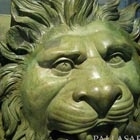ZOOM Fabergé Eggs - Moscow Kremlin Egg
1906 Easter gift to Alexandra, workmaster unknown
Moscow Kremlin Egg (1906)
Materials: Onyx, quatre-couleur gold, silver, opalescent white and translucent guilloche green enamel, glass, oil painting
Dimensions: Height of egg: 361 mm. (14 3/8 in.)
Base of egg: 185 mm. x 185 mm. (7 1/4 in. x 7 1/4 in.)
Owner: Armoury Museum of the Kremlin, Moscow
This egg, also known as the Uspenski Cathedral Egg, is the tallest of the known Imperial Easter eggs. It represents the Uspenski (Dormition) Cathedral where the tsars of Russia were crowned. Based on a cup attributed to the Nüremberg copper and silversmith Sebastian Lindenast, the elder (ca. 1460–1526), the walls, towers, and staircases are clustered around the central, opalescent white enamel egg, the top of which takes the form of a graceful yellow gold cupola. The turrets of the Kremlin are fashioned in red gold and the roofs are enameled translucent light green. There are chiming clocks in two of the towers, the dials measuring about half an inch (12 mm.) in diameter. The Spasskaia Tower, which is duplicated, bears the coat of arms of the Russian Empire and of Moscow. Through the glass windows of the egg can be seen a minutely accurate representation of the interior of the cathedral, with its rich carpets, decorations, and High Altar, shown on an oval glass plate.
Two Cherubim chants, traditional triumphal Easter hymns, are played when a clockwork mechanism is wound up by a gold key two and a half inches long. Tiny enameled icons of Our Lady of Kazan and Christ Pantocrator decorate the walls of the cathedral. The egg, which rests on an octagonal white onyx base, is consciously designed as a pyramid and is built up of other smaller pyramids.
The making of this egg marked the Imperial couple’s return to Moscow in 1903. They had tended to avoid the capital following a disastrous incident during the celebrations to mark their coronation. Scholars believe the egg was to have been presented in 1904, but there was a delay until 1906, probably because of the Russo-Japanese War or the assassination of Grand Duke Sergei Alexandrovich, Nicholas II’s favorite uncle and brother-in-law. Despite these sad associations, the Moscow Kremlin Egg held the most prominent position in Alexandra Fedorovna’s display cabinet in the Mauve Sitting Room of the Alexander Palace. The tsarina was deeply religious and became more so with age.





 Imperial Bedroom
Imperial Bedroom Portrait Hall
Portrait Hall Mauve Room
Mauve Room Maple Room
Maple Room Aleksey's Bedroom
Aleksey's Bedroom Nicholas's Study
Nicholas's Study Aleksey's Playroom
Aleksey's Playroom Formal Reception
Formal Reception Balcony View
Balcony View Aleksey- Balcony
Aleksey- Balcony Children-Mauve
Children-Mauve Nicholas's Bathroom
Nicholas's Bathroom Alexandra- Mauve
Alexandra- Mauve Nicholas's Reception
Nicholas's Reception Tsarskoe Selo Map
Tsarskoe Selo Map